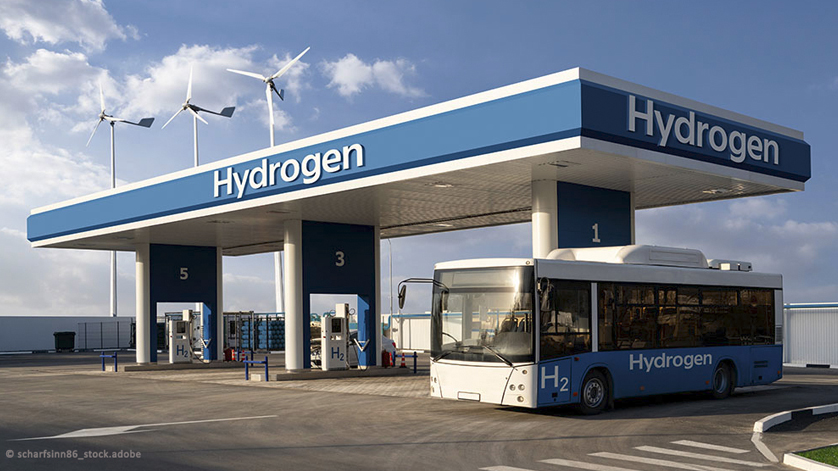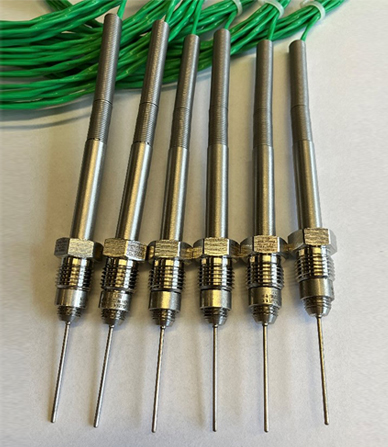
Hydrogen is playing an increasingly important role as an alternative energy source, including as a climate-friendly fuel for motor vehicles. Its physicochemical properties make the supply of H2 to cars and commercial vehicles a challenge for measurement technology. For example, the temperature is a critical variable when refuelling with hydrogen. Monitoring it requires a specific thermocouple. A manufacturer of H2 refuelling systems has therefore opted for instrumentation from WIKA.

Robust and responsive: The model TC90 high-pressure thermocouple is designed for temperature monitoring during hydrogen refuelling.
At first glance, filling stations for hydrogen-powered vehicles, so-called hydrogen refuelling stations (HRS), hardly differ from those for conventional combustion engines. The handles for refuelling at the H2 pumps, referred to as dispensers, also look familiar. However, a look at the equipment reveals that no petrol or diesel flows through the supply line; the filler neck for the vehicle tank is designed to be resistant to high pressures.
H2 heats up on expansion
Hydrogen for refuelling is compressed with a pressure of up to 900 bar, a compression adjusted to the usual tank pressure of 700 bar. The greater the pressure difference between the dispenser and the vehicle, the faster the hydrogen flows, thus shortening the refuelling process. However, there is one critical aspect to bear in mind here – in contrast to other gases, hydrogen heats up during expansion.
This is why temperature monitoring plays a crucial role when refuelling with hydrogen. This task takes place in a range between -40 °C and +85 °C. The lower value is the temperature of the hydrogen at the start of the refuelling process, achieved by cooling it down using a heat exchanger. The higher value corresponds to the maximum temperature for which the standard H2 vehicle tanks are specified. These are type 4 carbon-fibre tanks.
Cooling the rising temperatures during hydrogen refuelling at an early stage
The temperature when refuelling with hydrogen must therefore never exceed +85 °C. If it approaches this value, the system slows down the refuelling process at an early stage and regulates it through cooling. To monitor the H2 temperature, a measuring instrument is required that combines sensitivity and robustness and also minimises the impact on the media flow. This is why the HRS manufacturer mentioned earlier chose the model TC90 high-pressure thermocouple from WIKA. The following reasons, in particular, supported choosing this instrument:
- The TC90 is compact and designed for measuring tasks in small nominal pipe widths.
- Its probe tip can withstand pressures of up to almost 900 bar that occur during hydrogen refuelling, even when it is unprotected.
- The version with high-pressure threaded connection, gives the TC90 the necessary strength and keeps the measuring location reliably sealed.
- The direct media contact of the probe ensures short response times of just a few seconds that are required for regulating the cooling.
- All wetted components are made of H2-compatible materials.
Thermocouple also available in combination with a SIL 2 transmitter
For use in refuelling systems, the TC90 thermocouple is available in explosion-protected versions in accordance with ATEX and IEC Ex. It is also available in combination with a WIKA transmitter, for example model T38 with Ex and SIL 2 approval.
Note
Further information on model TC90 high-pressure thermocouple as well as model T38 temperature transmitter can be found on the WIKA website. There you will also find a complete overview of WIKA solutions for the production and use of hydrogen, including for hydrogen refuelling stations. If you have any questions, your contact will gladly help you.
Also read our posts
Pressure switch in hydrogen-powered train ensures safety
WIKA develops pressure sensor for hydrogen-powered vehicles
Turning hydrogen into kilometres
Hydrogen and pressure sensors: What must be observed?
You can also watch an interview on WIKA measurement technology for H2 applications:

